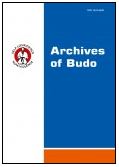2021, Volume 17
The diagnostic value of the ‘Rotational Test’ in preclinical studies – an example of combat- and non-combat sports athletes research before and after an alpine skiing course
Artur Litwiniuk1, Małgorzata Knas2, Juris Grants3
1Faculty of physIcal Education and Health in Biała, Jozef Pilsudski University of physical Education, Warsaw, Poland
2Lomza State University of Applied Sciences, Lomza, Poland
3Latvian Academy of Sport Education, Riga, Latvia
Full text
Abstract
Background and Study Aim: Alpine skiing is a physical activity that stimulates (develops and maintains) primarily coordination motor abilities, mainly the balance of the body. Thus, for combat sports (martial arts) athletes, on the one hand it can be a means (a supportive sport) that enhances the body balance disturbances tolerance skill (BBDTS). On the other hand, the optimal BBDTS level increases the likelihood of learning to ski safely and is the basis for forecasting satisfactory motor effects during a few days of basic skiing course. The aim of this research was knowledge about the relationship between BBDTS and the motor effects of an intensive, multi-day basic alpine skiing course and with the body composition indices of combat- and non-combats sport athletes.
Material and Methods: Twenty-four physical education students were examined: 12 training combat sports (including 1 neo-gladiator); 12 (control group) practicing other sports or daily, varied physical activity. Age of the surveyed students (respectively); body height; body mass. The basic skiing course lasted 10 days: 6 teaching hours (45 minutes each) a day. Motor effects (skiing techniques) were assessed by 3 experts on a scale from 2 to 5 (with an accuracy of 0.5) and the criterion was the arithmetic mean of all scores. ‘Rotational Test’ (RT – quasi-apparatus version) measured the BBDTS. RT consists of six tasks (consecutive jumps with body rotation of 360° alternately to the right and to the left). The overall result (motoric aspect) is the sum of the six tasks and includes 0 to 18 stipulated points. Criteria of an individual level of BBDTS are as follows: very high (0-1), high (2-3), average (4-9), low (10-12), very low (13-15), insufficient (16-18). The execution time (s) RT was a qualitative supplementary criterion. Body composition was measured device Tanita 545N. Statistical analysis was based on a non-parametric Shapiro-Wilk Normality Test.
Results: Combat sports students athletes revealed a higher level of BBDTS (as documented by motor indexes and RT execution time) both before and after the basic alpine skiing course: before 0.42 ±0.49 RT points, 12.21 ±0.73 RT s; after 0.75 ±0.92 RT points, 12.41 ±0.83 RT s; other students (respectively): 5 ±1.47 points, 13.88 ±0.86 s; after 5.88 ±2.02 points, 14 ±0.93 s. The differences between the groups are statistically significant (p<0.01 or p<0.05). The motor learning outcomes of alpine skiing by students were similar.
Conclusions: This slight deterioration of both RT indices was found in both groups proves that intensive, long-lasting alpine skiing training is a significant neuro-physiological burden on the organism, regardless of previous motor specialization. Moreover, RT results prove that combat sports (martial arts) shapes BBDTS in an optimal way. Both RT evaluation criteria (points and test time) suggest that they are sensitive indicators and can be recommended as useful in preclinical studies of the nervous system (with certain limitations), that is the some aspects of the condition of organs and functions responsible for maintaining the balance of the body during human motor activity.
Key words: body composition, motor safety, nervous system, preclinical test




